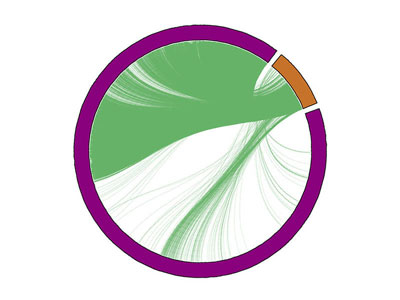| Jan 21, 2015 |
Mathematics improve single-cell analysis
|
|
(Nanowerk News) A new computational approach allows to account for confounding factors and hidden biological processes in the analysis of single-cell RNA sequence data. Using this method, individual subpopulations and cell types can be identified within heterogeneous cell populations and can be determined more precisely. Scientists from Helmholtz Zentrum München (HMGU) and Technische Universität München (TUM), together with colleagues from the European Bioinformatics Institute (EBI), have now reported these findings in the journal Nature Biotechnology ("Computational analysis of cell-to-cell heterogeneity in single-cell RNA-sequencing data reveals hidden subpopulations of cells").
|
 |
| More than 40% of all genes in the experiment were significantly correlated to a small set of known cell-cycle markers (orange). (Graphic: Florian Büttner / HMGU)
|
|
Cell populations have a high heterogeneity, even when they consist of the same type of cells. To determine various types of cells, scientists analyze the respective active transcriptome – in the form of RNA molecules – of the individual cells. Recent technical developments of this so-called single-cell analysis have enabled the transcriptomes of hundreds of cells to be assayed, thus providing an exact picture of the individual cell types.
|
|
However, the observed differences between the gene expression patterns of individual cells result from numerous sources, including confounding factors, such as short-term changes in gene expression due to the cell cycle as well as biological processes of interest such as stem cell differentiation.
|
|
Dissecting heterogeneity
|
|
The scientists have now developed a statistical approach, which models the sources of the observed cell-cell differences. This facilitates an accurate dissection of the observed heterogeneity into a variety of factors, which include measurement noise, confounding factors such as cell cycle effects as well as the biological processes of interest.
|
|
“In our current study we show how such factors can be taken into account, thus enabling a more accurate picture of the different cell types. Through the combination of single-cell analyses with statistical methods, cell types can be identified that otherwise would remain undetected,” said first author Florian Büttner of the Institute of Computational Biology (ICB) at Helmholtz Zentrum München.
|
|
Single-cell profiles: towards a better understanding of health and disease
|
|
Using their single-cell latent variable model (scLVM), the team around Florian Büttner from Helmholtz Zentrum München and Fabian Theis, Professor for Mathematics in Systems Biology at TU München, as well as John Marioni and Oliver Stegle from the European Bioinformatics Institute (EMBL-EBI, Cambridge, UK) have succeeded in detecting and characterizing the maturation stages of T-helper cells.
|
|
T-cells are immune cells that differentiate into different shapes, such as Th2-cells (T-helper cell type 2) to exert various immune functions. The analysis of single cell types is essential for medical research. Cancer cells, differentiation processes, the pathogenesis of various diseases and much more can be better explored and understood based only on known, detailed cell profiles.”
|
|
"Modern single cell analysis has shown that there are significant differences within an apparently homogeneous cell population. Our long-term goal is to understand the biological and technical causes of these heterogeneities," says Professor Fabian Theis. "This requires modern multivariant statistical and computational methods that we develop with our colleagues at the EBI."
|

